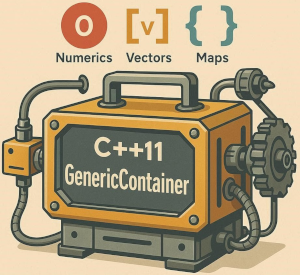Brief description of the class and features
The GenericContainer class is a powerful and flexible data structure designed to manage a wide variety of data types and structures.
Its capabilities include storing integers, floating-point numbers, strings, vectors, matrices, maps, and and complex numbers.
This manual is a simple guide to using the GenericContainer class, providing explanations, usage examples, and descriptions of various functionalities.
Features
- I/O: Allows reading and writing formatted data from and to files.
- Interfacing: Read and save to JSON, YAML and TOML files. SUpport for interfacing with MATLAB, RUBY and PYTHON.
- Serialization: Facilitates serialization and deserialization of the entire container.
- Error Handling: Comprehensive error handling with exceptions and error codes.
- Flexibility: Supports nested containers, enabling complex data structures.
Class Overview
The GenericContainer class is designed to be generic, allowing the user to store any data type. It provides methods to manipulate the stored data and to perform various operations, including:
- Setting and getting values.
- Managing collections of data with vectors and maps.
- Read/write to string and files.
- Serializing and deserializing of the container.
Supported types
- pointer
- boolean
- integer
- long integer
- floating point
- complex floating point
- string
- vector of pointer
- vector of boolean
- vector of integer
- vector of floating point
- vector of complex floating point
- vector of string
- matrix of floating point
- matrix of complex floating point
in addition to this data type the following two container data are avaiable
- vector of GenericContainer
- map of GenericContainer
this permits to build complex recursive data. The main usage of the class is in interchange data with scripting language like Ruby, Lua, MATLAB.
Simple Usage
The usage is simple, for example it can be used as an associative array with eterogenous data
GenericContainer gc;
gc["one"] = 1;
gc["two"] = true;
gc["3"] = 1.4;
gc["four"] = "pippo";
gc["five"].set_vec_int(10);
and to retrieve elements
cout << gc["one"].get_int() << '\n';
cout << gc["two"].get_bool() << '\n';
cout << gc["3"].get_real() << '\n';
cout << gc["four"].get_string() << '\n';
GenericContainer::vec_int_type & v = gc["five"].get_vec_int();
cout << v[1] << '\n';
For more complex examples and recursive data see example test files in the distribution or the Usage section of the manual.

